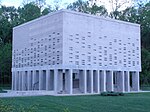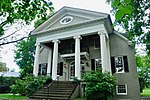Louisville Water Tower
1860 establishments in Kentucky19th-century buildings and structures in Louisville, KentuckyFormer pumping stationsHistoric American Engineering Record in KentuckyHistoric Civil Engineering Landmarks ... and 9 more
Infrastructure completed in 1860Infrastructure in Louisville, KentuckyNational Historic Landmarks in KentuckyNational Register of Historic Places in Louisville, KentuckyTourist attractions in Louisville, KentuckyTowers completed in 1860Use mdy dates from August 2023Water towers in KentuckyWater towers on the National Register of Historic Places

The Louisville Water Tower, located east of downtown Louisville, Kentucky near the riverfront, is the oldest ornamental water tower in the world, having been built before the more famous Chicago Water Tower. Both the actual water tower and its pumping station are a designated National Historic Landmark for their architecture. As with the Fairmount Water Works of Philadelphia (designed 1812, built 1819–22), the industrial nature of its pumping station was disguised in the form of a Roman temple complex. In 2014, the Louisville WaterWorks Museum opened on the premises.
Excerpt from the Wikipedia article Louisville Water Tower (License: CC BY-SA 3.0, Authors, Images).Louisville Water Tower
Zorn Avenue, Louisville
Geographical coordinates (GPS) Address External links Nearby Places Show on map
Geographical coordinates (GPS)
| Latitude | Longitude |
|---|---|
| N 38.280555555556 ° | E -85.701111111111 ° |
Address
Zorn Avenue
40206 Louisville
Kentucky, United States
Open on Google Maps





